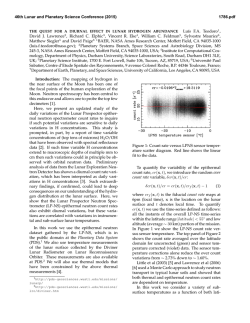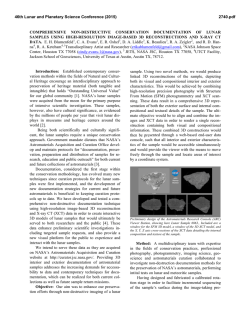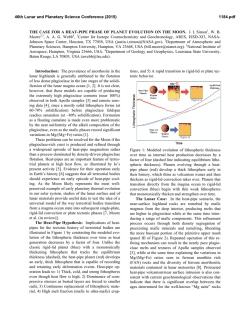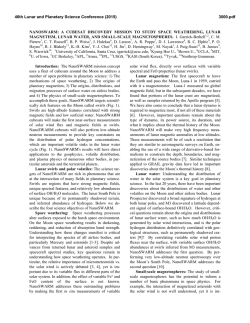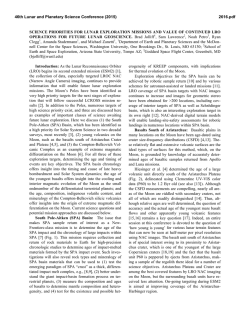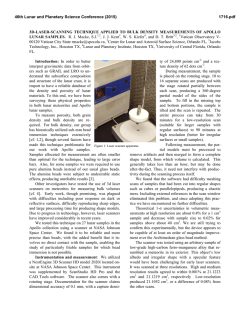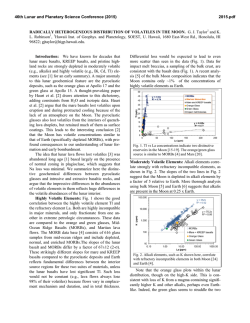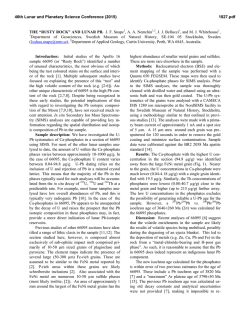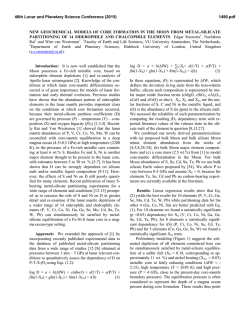
Lunar and Planetary Surface Water Distribution Systematics via
46th Lunar and Planetary Science Conference (2015) 1108.pdf Lunar and Planetary Surface Water Distribution Systematics via Deep Space Cubesat Orbiter with Compact Broadband IR Instrument. P.E. Clark1,3, N. Petro2, D. Reuter2, R. MacDowall2, A. Mandell2, D. Patel2, S. Banks2, W. Farrell2, B. Malphrus4, R. Cox3, 1IACS, Catholic University of America, Washington, D.C. 20064, 2 NASA/GSFC, Greenbelt Road, Greenbelt, MD 20771, 3Flexure Engineering, 3518 Fremont Ave. N, #474, Seattle WA 98103, and 4Space Science Center, Morehead State University, Morehead, KY 40351 Contact Email: [email protected] Purpose: Having developed the CubeSat Paradigm for science requirements-driven deep space exploration, referred to as a LunarCubes [1], have been developing a 'workhorse' instrument capable and resource (including volume) minimized enough to provide high priority volatile science on deep space cubesats [2], and are planning to develop a 6U lunar orbiter for EM1 [2]. We focus on cubesat exploration to lunar exploration because of the Moon's proximity and accessibility as a stepping stone to the rest of the solar system, combined with the great international scientific interest in the Moon and its suitability as an analog with extreme range of conditions and thus an ideal technology testbed for much of the solar system. Science Rationale: 6U deep space capable cubesat buses and deployers are now available. We are part of an effort to develop CubeSat instruments capable of providing focused, high priority science, so critical to achieving the potential for low cost planetary exploration promised by the CubeSat paradigm, which up until now has lagged behind. Our mission concept, LWaDi (Lunar Water Distribution) with payload BIRCHES (Broadband InfraRed Compact High-resolution Exploration Spetrometer) is designed to do what previous lunar missions (Clementine, Chandrayaan, LRO/LCROSS), although they unexpectedly discovered signatures for components and forms of water and other volatiles, were not optimized and/or designed due to limited spectral range (<3 microns) and resolution. The innovatively designed spectrometer will have the high spectral resolution (5 nm), broad range (1 to 4 µm) and LWaDi will have the science orbit (inertially locked, highly elliptical; equatorial, low altitude periapsis) to provide spectral coverage for the same features at a different time of day during several lunar cycles). Measurements: By providing BIRCHES measurements of major forms and components of water, including characterization of both sides of the broad 3 micron band associated with water ice and hydroxyl with the orbital trajectory described above, LWaDi will reveal 1) the systematics of water and other volatiles as a function of time of day, latitude, and type of feature; 2) a geological context for those measurements through spectral determination of mineralogical composition, maturity; and 3) an expanded understanding of the current dynamics of volatile sources, sinks, and processes with implications for the distribution, abundance, origin, and evolution of the lunar and other at- Figure 1: LWaDi Orbiter Configuration. Nadirpointing instrument in bottom left. mosphereless small body, surfaces and interiors. Patterns in water form and component distribution as a function of feature type (volcanic versus impact), age and composition, as well as regolith temperature (latitude) and illumination (shadowing) regimes, radiation and particle exposure, and time of day, will provide input crucial for understanding the role of external sources, internal sources, and solar wind proton and micrometeorite bombardment in formation, trapping, releasing of water and exosphere formation [3]. Systematic identification of the forms and components of water and organics could reveal the contributions of amorphous ice coated dust grains, amorphous organics, and metallic components to the lunar regolith [4]. Cubesat Bus: We have conducted the equivalent of a pre-phase A study for a lunar cubesat orbiter, with a focus on the several payloads capable of characterizing the lunar environment, one of which is described below. Subsystems include state of the art cubesat attitude control, propulsion, communication, power, thermal and radiation protection systems providing lunar orbital operation of a cubesat bus. Based on this work, we have concluded that a 6U bus with state of the art cubesat systems already available or now being built and tested can support a high priority science orbiter in cislunar space, providing the spacecraft is delivered to GEO/GTO or beyond. Particular challenges for orbiters or impactors are communication, navigation and tracking in a volume, power, and bandwidth constrained environment. Thermal and radiation protection 46th Lunar and Planetary Science Conference (2015) Figure 2: BIRCHES ray tracing illustrating design details that make optical system compact and flexible, including the LVF and adjustable iris. will be the principal challenges for landed cubesat deployables. The end result is generic design(s) for a cross-section of future high priority payloads for planetary, heliophysics, and astrophysics disciplines. Instrument: In response to the need for 'workhorse' cubesat instruments, we are developing BIRCHES, Broadband InfraRed Compact, Highresolution Exploration Spectrometer, a miniaturized version of OVIRS on OSIRIS-REx. BIRCHES is a compact (1.5U, 2 kg, <5W) point spectrometer with a compact cryocooled HgCdTe detector for broadband (1 to 4 micron) measurements at sufficient resolution (10 nm) to characterize and distinguish important volatiles (water, H2S, NH3, CO2, CH4, OH, organics, oxides, carbonates) and mineral bands. It has built in flexibility, using an adjustable 4-sided iris, to maintain the same spot size regardless of variations in altitude (by up to a factor of 5) or to vary spot size at a given altitude, as the application requires. In this way, we will develop a competitive instrument for future deep space CubeSat opportunities such as EM-1. References: [1] Flexure Engineering, Lunar Intitiatives, http://lunarinitiatives.com/; [2] Clark et al, 2014, http://www.lpi.usra.edu/meetings/leag2014/pdf/3007.p df; [3] Robinson and Taylor, 2014, Nature Geoscience, 7DOI:10.1038/NGEO2173; [4] Rivkin and Emery, 2010, Nature Letters, 464, doi:10.1038/nature09028. 1108.pdf
© Copyright 2026
